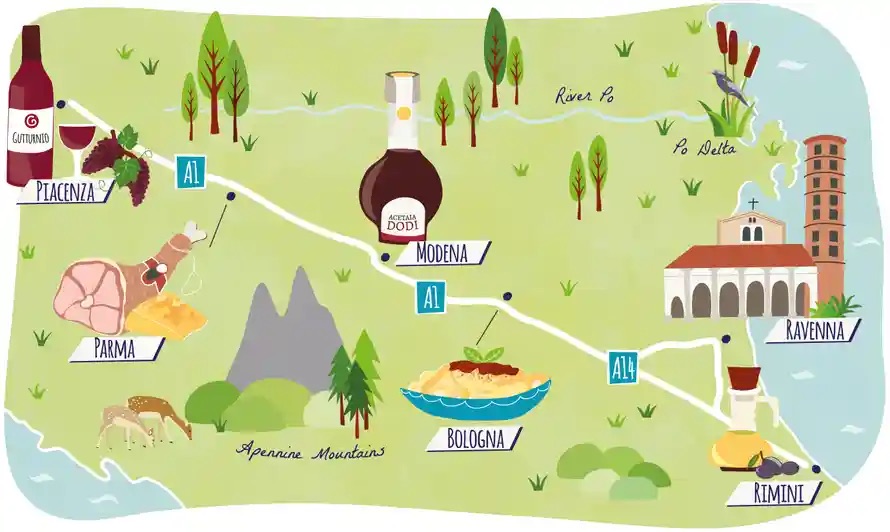Whenever I think of Italy, I think back to my first trip with my mother in my late teens. I felt vulnerable twirling down the winding roads to the Almalfi coast. If you have had this experience, you will understand my fear was justifiable. You cannot walk through the streets and not notice the beautiful smell of fresh lemons hanging from the trees throughout the town. I did not, however, find myself drawn to thoughts of the beautiful Region in Italy of Emilia Romagna.
Emilia-Romagna is a region in Northern Italy that extends inland westward from the Adriatic coast. Parmigiana Reggiano originated from Parma – a beautiful town rich in art and architecture, with a splendid Romanesque Church and Baptistery and covered theatre; it is also famous for prosciutto or ham.

Illustration: Bek Cruddace
Why Is It The King Of Cheese?
The main differences between Parmesan and Parmigiano-Reggiano are their ageing processes and how the DOP regulates their ingredients. For the cheese to be classified as Parmigiano-Reggiano, it must come from particular regions of Italy and contain only the approved ingredients of cow’s milk, whey and an enzyme called rennet. Parmigiano-Reggiano is aged for a minimum of 12 months, 24 months, 36 months and sometimes more. However, Parmesan, on the other hand, is not regulated and may be aged as little as ten months.
The idea of visiting Parma, the birthplace of Parmagianna Reggiano, filled me with excitement. To watch and experience the making of the king of cheese. We were driven out approximately 20 minutes from the centre of Parma to a beautiful dairy farm in Caseifco, surrounded by beautiful countryside. As we vacated the car, you were hit by the smell of milk. Not the kind you will find in supermarkets. Real milk. Greeted by our lovely guide and donned our hazmat like outfits. We entered a large warehouse room where there were sizeable bell-shaped copper vats filling being filled with the milk from yesterday and this morning, approximately 550 litres of milk to produce each wheel of Parmigiano Reggiano. The milk is brought to a temperature of 55 degrees centigrade. The milk slowly and naturally thickens with the addition of rennet and a whey starter, rich in starter cultures from the previous day’s processing, and just like magic, the cheese-making process starts to happen. The cheese master then uses a traditional tool called a “spino” to break down the curd that has formed into tiny granules.
It is lifted and separated from the whey using a large cloth and divided into two forms. It is then placed into the wheels and turned every so often to keep the shape for 48 hours. Next, they use the embossed stamps for Parmigiano Reggiano when the cheese is still soft. The wheels are then immersed in a saturated solution of water and salt: a process of salting by osmosis. This last passage closes the production cycle of Parmigiano Reggiano and starts its maturation period. It was beautiful watching the cheese master oversee every step of the process and working with so much passion for perfection. He wore all white and a large white apron and wellington boots. His appearance reminded me of Carl’s character from the movie Up. The cheese masters in any Parmigiana Reggiano Dairy are highly skilled and work seven days a week.
Fortunately, on this trip, I had the opportunity to sample many.

The Cheese master (photo by Samantha Cook)
delightful l delicacies specific to this region, including a trip to Moderna. It was to a quaint Italian house, and I learned all about their family business that had been in their family for three generations producing balsamic vinegar approved by the DOP and the process of how they make their balsamic and was fascinated to discover that a real balsamic will be aged a minimum of 12 years and the different barrels they use to produce different flavours like cherry and oak. They keep the barrels in the attic as the conditions are best for fermentation. The longer they ferment, the thicker they become, and a richer flavour develops. The different variations would pair better with certain foods.

Barrel aged Balsamic vinegar (photo by Samantha Cook)
If you ever have the opportunity, I highly recommend a trip to a good cheesemonger and requesting to sample at least two different aged Parmigiana Reggiano (ideally more) to experience the difference; as they age, they take on a more nutty flavour and develop a wonderful crunch.
I discovered this dish on several menus throughout Parma and have tried to recreate this dish to be enjoyed. Pumpkin was on all the menus; however, it changes seasonally to suit the locally available vegetables.

Pumpkin Flan with Parmesan Cream (Photo by Samantha Cook)
Here is my take…
Pumpkin Flan with Parmigiana Reggiano Cream
Ingredients
Serves 4
Cooking time 1 – 1 hour 20
Preheat oven to 180°/gas mark 4
Flans:
- Extra virgin olive oil
- 500g pumpkin peeled, deseeded and cubed
- 1 medium red onion peeled and grated
- 50g of peeled red lentils
- 2 eggs
- 50g of grated Parmigiano Reggiano
- Extra virgin olive oil
- Sea salt, white pepper
Bread Crumbs
- Extra virgin olive oil
- 25g of bread crumbs (this is a great way to use up stale bread)
- 1/2 teaspoon of dried thyme
Cheese fondue:
- 100g grated Parmigiana Reggiano
- 200g fresh cream
To Plate:
- A sprinkle of toasted pumpkin seeds
- If you have available a leave of fresh basil
Method
Flan
Over medium heat, add a splash of olive oil and the onion. Cook for 4-6 minutes, occasionally stirring to ensure it does not brown too much. Once cooked, add the pumpkin, lentils and a pinch of salt and cook with the lid. If the mixture starts to stick, add a tablespoon of water. Once the pumpkin is tender, remove it from the heat.
Whilst this is cooking, start your bread crumbs. Place a pan on medium heat and add a generous coating of olive oil. Once the oil is hot, add the breadcrumbs and let it toast, and add the dried thyme and cook for a further minute. If the bread is too dry, add a splash of more oil and salt and pepper to taste. Wrap in a kitchen towel and set aside.
Add the eggs and purée in a blender or stick blender to ensure the mixture is smooth, and add salt and pepper to taste. At this stage, I would hold back on the salt as the Parmigiano in the fondue will also add a salty flavour. Divide into four individual ramekins
Bake in the preheated oven, in a bain-marie, for 20-5 minutes or until the surface is golden. Allow to cool slightly, remove from the ramekin, and present on a plate top side up.
Whilst the flan is cooling, you can start preparing the cheese fondue. Add the cream to a small pan and heat over medium heat. Add the grated cheese and cook until the cheese has melted, and whisk to a thick sauce consistency. If it becomes too thick you can add a splash of milk to get to the desired consistency. Remove from the heat and set aside
Plating
Put the flan in the centre of a flat dish topside up and surround it with a little fondue. Add crispy bread over it. A leave or two of fresh basil. Salt and pepper to taste.

 WhatsApp us
WhatsApp us